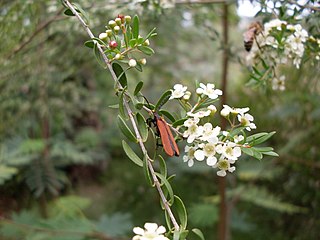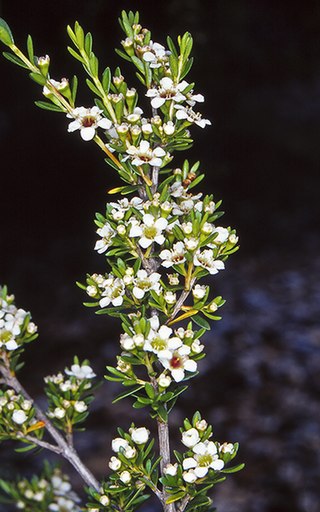
Baeckea brevifolia is a species of flowering plant in the family Myrtaceae and is endemic to south-eastern New South Wales. It is a shrub with narrow egg-shaped to oblong leaves and white to pink flowers with nine to fifteen stamens.

Sannantha pluriflora, commonly known as tall baeckea, is a species of flowering plant in the myrtle family, Myrtaceae, and is endemic to continental southeastern Australia. It is a shrub or small tree with lance-shaped to elliptic leaves, and groups of two to nine white flowers arranged in umbels in leaf axils.

Baeckea imbricata, commonly known as heath myrtle, is a species of flowering plant in the family Myrtaceae and is endemic to eastern Australia. It is a shrub with elliptical to egg-shaped or round leaves and small white flowers with five to twelve stamens.
Baeckea latens is a species of flowering plant in the family Myrtaceae and is endemic to the south of Western Australia. It is an upright, spreading shrub with erect, linear leaves and small white flowers with three to ten stamens.
Baeckea uncinella is a species of flowering plant in the family Myrtaceae and is endemic to the south coast of Western Australia. It is a shrub with narrowly egg-shaped to linear leaves and small white flowers with seven to thirteen stamens.

Baeckea gunniana, commonly known as alpine baeckea, is a species of flowering plant in the family Myrtaceae and is endemic to alpine and sub-alpine areas of south-eastern Australia. It is a densely-branched shrub with egg-shaped to oblong leaves and small white flowers with four to six stamens.

Leptospermum lamellatum is a species of shrub or small tree that is endemic to inland Queensland and has distinctive reddish, layered bark. It has narrow elliptical leaves, white flowers and small fruit that fall from the plant when mature.
Triplarina calophylla is a species of flowering plant in the myrtle family, Myrtaceae and is endemic to a restricted area of north Queensland. It is a shrub with egg-shaped leaves with the narrower end towards the base, flowers with five sepals, five white petals and fourteen or fifteen stamens.

Triplarina imbricata, commonly known as creek triplarina, is a species of flowering plant in the myrtle family, Myrtaceae and is endemic to northern New South Wales. It is a shrub with weeping branches, narrow egg-shaped leaves, and flowers in pairs with five sepals, five relatively small white petals and fourteen to seventeen stamens.
Triplarina nitchaga is a species of flowering plant in the myrtle family, Myrtaceae and is endemic to a restricted area of north Queensland. It is a shrub with lance-shaped leaves with the narrower end towards the base, flowers with five sepals, five white petals and seventeen or eighteen stamens.

Triplarina volcanica is a species of flowering plant in the myrtle family, Myrtaceae and is endemic to Queensland, where it is only found in three mountainous areas. It is a shrub with elliptical to egg-shaped leaves with the narrower end towards the base and flowers with five sepals, five white petals and fourteen to sixteen stamens.
Thryptomene remota is a species of flowering plant in the family Myrtaceae and is endemic to the northern part of the Northern Territory. It is an erect shrub with linear to lance-shaped leaves with the narrower end towards the base, and white or cream-coloured flowers with ten stamens.

Baeckea diosmifolia, commonly known as fringed baeckea, is a species of flowering plant in the family Myrtaceae and is endemic to eastern Australia. It is a shrub with lance-shaped leaves with the narrower end towards the base, and white flowers with seven to nine stamens.

Baeckea frutescens is a species of flowering plant in the family Myrtaceae and is native to eastern Southeast Asia, New Guinea and Australia. It is a shrub with arching branches, linear leaves and white flowers with seven to thirteen stamens.
Baeckea kandos is a species of flowering plant in the family Myrtaceae and is endemic to a restricted area of New South Wales. It is a spreading shrub with narrow egg-shaped to linear leaves and small white flowers with ten to twelve stamens.

Baeckea latifolia is a species of flowering plant in the family Myrtaceae and is endemic to south-eastern continental Australia. It is a shrub with broadly elliptic leaves and small white flowers with six to eight stamens.

Baeckea leptocaulis is a species of flowering plant in the family Myrtaceae and is endemic to Tasmania. It is a shrub with linear leaves and small white flowers with five or six stamens.
Baeckea trapeza is a species of flowering plant in the family Myrtaceae and is endemic to Queensland. It is a shrub with lance-shaped leaves with the narrower end towards the base, and white flowers with eight to eleven stamens.

Baeckea utilis, commonly known as mountain baeckea, is a species of flowering plant in the family Myrtaceae and is endemic to south-eastern continental Australia. It is a shrub with elliptic to lance-shaped leaves with the narrower end towards the base and white flowers, usually with eight stamens.
Sannantha angusta is a species of flowering plant in the family Myrtaceae, and is endemic to eastern Australia. It has scaly to fibrous bark, narrowly lance-shaped to linear leaves and white flowers, and usually grows in forest on rocky hillsides. It was previously known as Babingtonia angusta, and has been cultivated as Baeckea sp. 'Clarence River'.













